Boat Propeller Cavitation CFD Simulation Tutorial
$200.00 $100.00 Student Discount
- The problem numerically simulates Boat Propeller Cavitation using ANSYS Fluent software.
- We design the 3-D model with the Design Modeler software.
- We mesh the model with ANSYS Meshing software, and the element number equals 2,446,879.
- The Mixture multiphase model was used to simulate the Cavitation.
To Order Your Project or benefit from a CFD consultation, contact our experts via email (info@mr-cfd.com), online support tab, or WhatsApp at +44 7443 197273.
There are some Free Products to check our service quality.
If you want the training video in another language instead of English, ask it via info@mr-cfd.com after you buy the product.
Description
Description
Cavitation is a phenomenon in which the static pressure of a liquid drops below the vapor pressure of the liquid, leading to the formation of small voids filled with vapor in the liquid.
When these cavities are subjected to higher pressures, they collapse and can create shock waves that may damage machinery. These shock waves are strong when close to the bursting bubble, but weaken rapidly as they propagate away from the burst.
Cavitation is an important cause of wear in some engineering fields. Collapsing cavities that explode near the metal surface cause cyclic stress through repeated bursting. This leads to fatigue of the metal surface, which causes a type of wear also called “cavitation”.
The geometry of the present project is designed in Design modeler and meshed in ANSYS Meshing software. The mesh type is unstructured and the element number is equal to 2,446,879.
Boat Propeller Cavitation Methodology
The Mixture multiphase model was used in this project to simulate the cavitation occurring in the vicinity of propeller’s blades. Cavitation occurs due to the pressure drop on one side of the blades. Schnerr-Sauer model has been enabled to simulate the cavitation and vaporization pressure limit was set to 3540 Pa.
Furthermore, SST k-omega model is used to solve for the turbulent fluid equations. This model provides higher accuracies when simulating external flows. The mesh motion option was also enabled to model the propeller’s physical rotation. The present study is performed in transient format and 3D.
Conclusion
As shown in the obtained results, the generated bubbles generated due to cavitation, cover the blades’ suction side entirely and a bit of trailing edge. This indicates that the rotational velocity of the propeller (1500 rpm) is very high, causing the super cavitation phenomenon to occur on the propeller surface.

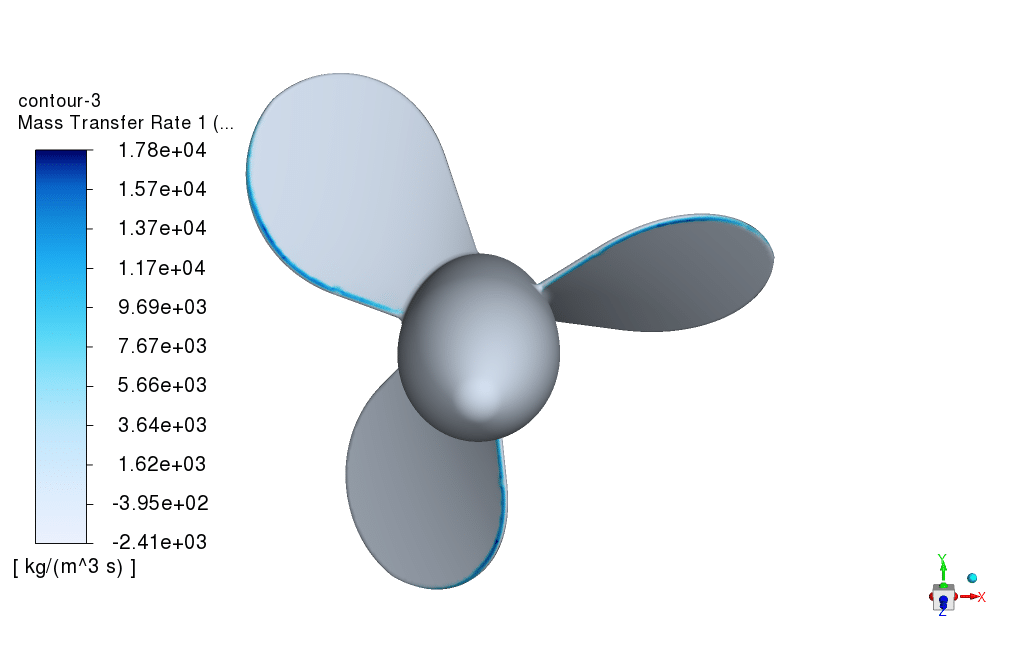








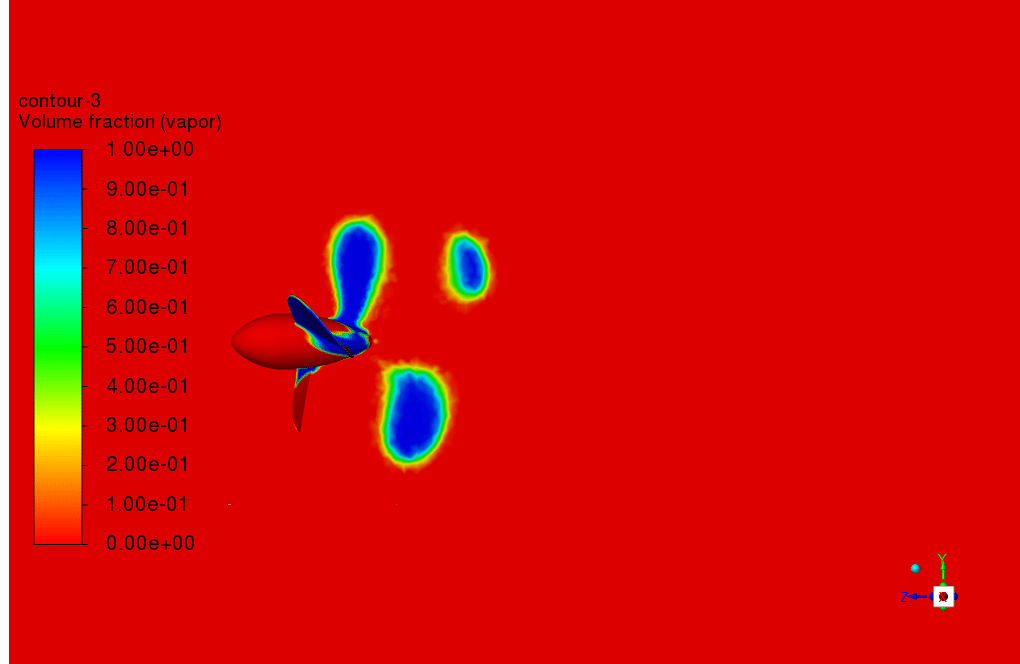

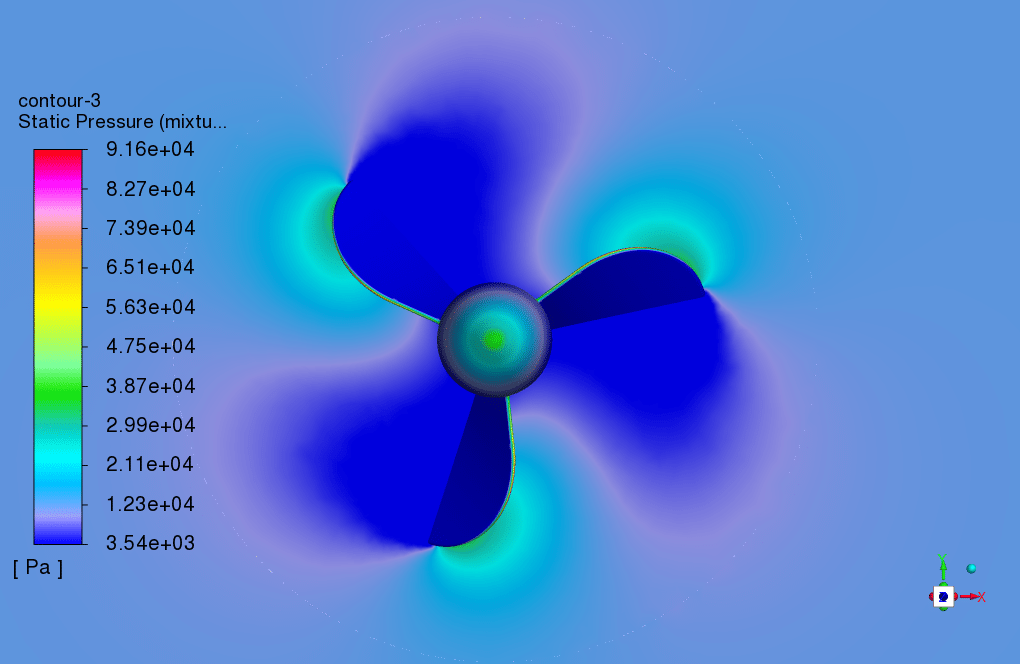


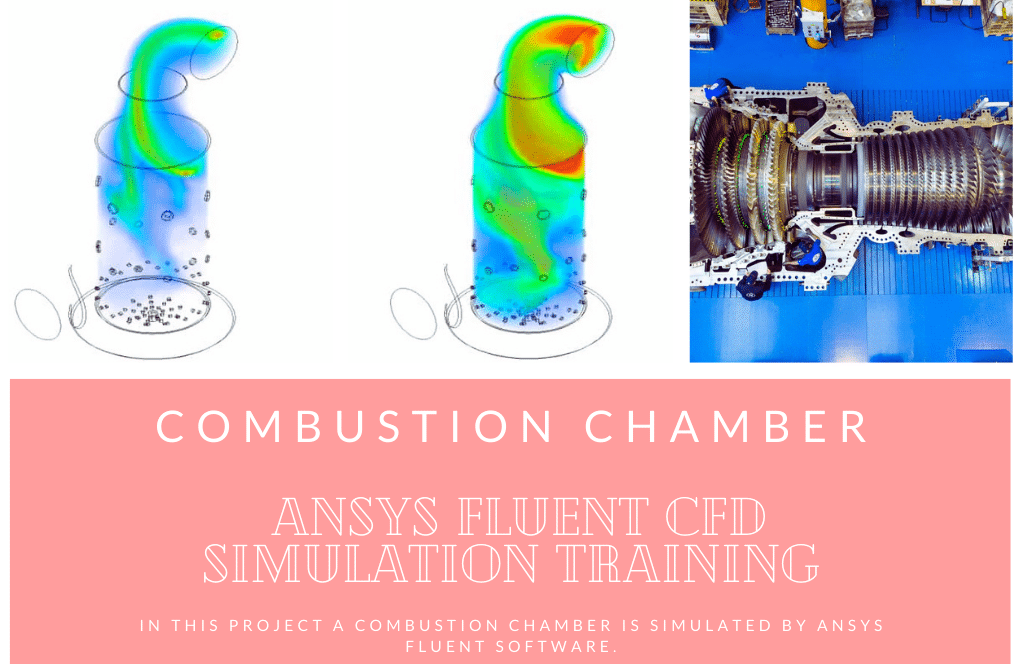

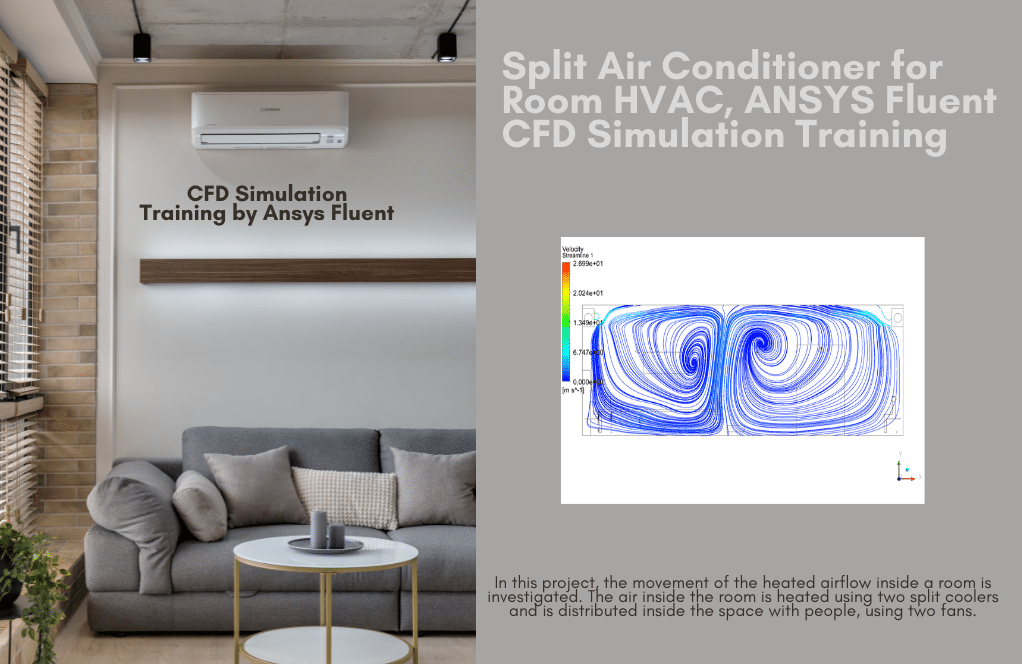

Vernice Prosacco –
I really appreciated how well the Boat Propeller Cavitation tutorial explained the complex phenomenon of cavitation and its impact on boat propellers. The step-by-step methodology provided a clear understanding of the simulation setup especially how the Schnerr-Sauer model is used for simulating the cavitation.
MR CFD Support –
Thank you for your positive feedback! We’re thrilled to hear that you found the tutorial comprehensive and informative. It’s great that the details on how cavitation affects boat propellers and the use of the Schnerr-Sauer model were helpful to you. Thanks again for choosing our product, and we hope it will continue to be a valuable learning resource for you.
Winnifred DuBuque –
I’m completely impressed by the effectiveness of the Mixture multiphase and Schnerr-Sauer models in capturing the cavitation around the propeller blades. It seems like it provides an accurate simulation of this intricate phenomenon. The tutorial must be incredibly detailed and informative to achieve such results!
MR CFD Support –
Thank you for your kind words! We’re delighted to hear that you are impressed with our Boat Propeller Cavitation CFD Simulation Tutorial. Our goal is to provide detailed and user-friendly guides to help our users accurately capture complex phenomena such as cavitation. We’re glad that the tutorial met your expectations!
Boyd Cormier –
The simulation looks incredibly thorough. It’s fascinating to know how the cavitation phenomena covers the blades and affects their performance. These insights are vital to improve the propeller design.
MR CFD Support –
Thank you for your positive feedback! It’s great to hear that our tutorial on Boat Propeller Cavitation CFD Simulation was helpful and provided valuable insights into the impact of cavitation on propeller performance. We are committed to delivering high-quality educational content and appreciate your recognition of our efforts.
Maximillia Borer –
The detailed analysis of cavitation on the boat propeller’s blades in this CFD tutorial really clarifies the practical implications of the phenomenon. The visuals of bubble formation were particularly enlightening.
MR CFD Support –
Thank you for your positive feedback! We’re thrilled to know you found the tutorial to be thorough and illuminating, especially with regard to the visualization of cavitation effects. Your understanding of this complex concept is essential and we’re delighted our materials could assist in your learning.
Stephania Emmerich –
I’m blown away by how well the Boat Propeller Cavitation CFD Simulation Tutorial demonstrated the impact of cavitation on the propeller. The visuals really helped me grasp how damaging it can be!
MR CFD Support –
Thank you for your kind words! We’re thrilled to hear that the tutorial was helpful and the visuals made the concept clear. Understanding cavitation is crucial in marine engineering and we strive to provide clear and effective educational materials. If you have any further questions or need more insights, let us know!
Ismael Hauck –
I just wanted to let you know that I’ve been thoroughly impressed with the Boat Propeller Cavitation CFD Simulation Tutorial! The level of detail was impeccable, especially regarding the explanation of cavitation and its causes. The practical application of the Schnerr-Sauer model in the tutorial made the complex concepts much more relatable. Please forward my thanks to the team responsible for this excellent resource!
MR CFD Support –
Thank you so much for your kind words! We are thrilled to hear that you found the tutorial detailed and helpful. Your appreciation is a huge motivation for our team. Rest assured that your thanks will be passed on to everyone involved. If you ever have more questions or need further assistance, don’t hesitate to reach out!
Denis Abshire –
I followed the Boat Propeller Cavitation tutorial precisely, and the detailed walk-through really enhanced my understanding of tackling cavitation in simulations. The step-by-step guidance was thorough and made complex concepts understandable, especially the application of the mixture multiphase model and the choice of the Schnerr-Sauer model for cavitation simulation. I successfully captured the cavitation around the propeller and observed the predicted super cavitation perfectly!
MR CFD Support –
Thank you for your kind words! We’re thrilled to hear the Boat Propeller Cavitation tutorial was helpful to you. It’s wonderful to know that our instructions facilitated your understanding of the multiphase model and the complexities of cavitation. Your successful simulation outcome is precisely what we strive for with our tutorials. Should you have any more questions or need further assistance in future projects, feel free to reach out. Happy simulating!
Aiyana Cassin –
The results from this tutorial seem very insightful. How does the propeller’s rotation affect cavitation and the final results?
MR CFD Support –
The rotation of the propeller significantly affects the cavitation phenomenon as it creates low pressure regions on the suction side of the blades due to the centrifugal forces. As the rotational velocity increases, these low-pressure regions can lead to cavitation, where vapor bubbles form and, upon collapse, potentially damage the propeller blades. The final results help in understanding where cavitation is likely to occur and to what extent, which is essential for optimizing propeller design and operation condition.
Joaquin Volkman –
This tutorial was incredibly detailed and I now have a much better understanding of how cavitation affects boat propellers. The visualization of the bubble formations was particularly enlightening.
MR CFD Support –
Thank you for the kind words! We’re glad to hear that our Boat Propeller Cavitation CFD Simulation Tutorial was helpful to you and that the visualizations of cavitation made the concepts clear. If you need further details or assistance with similar simulations, feel free to reach out.
Mr. Ari Sauer V –
I’m impressed with the thoroughness of your simulation! The cavitation phenomenon has been eloquently captured, and I’m curious to know how accurately it predicts the actual wear on the propeller blades. Great job on the detailed setup and the well-thought-out parameter choices!
MR CFD Support –
Thank you for your kind words! We always strive to provide detailed simulations and are delighted to hear that the cavitation phenomenon was accurately represented. Our goal is to make our simulations as realistic as possible for better predictive insights into wear and tear on machinery. Your feedback is greatly appreciated!
Reyes Mitchell –
Absolutely impressed by how detailed the simulation was in illustrating the cavitation process around the propeller blades. It beautifully captures not just the formation of vapor-filled voids but their eventual collapse and subsequent effects on the blades’ material integrity.
MR CFD Support –
Thank you for your positive feedback on our Boat Propeller Cavitation CFD Simulation Tutorial. We’re delighted to hear that you were impressed with the detail and accuracy of the simulation and its ability to visualize the cavitation phenomena effectively. Your satisfaction with our learning product is very much appreciated!
Patsy Simonis –
I’m impressed by how cavitation patterns are accurately predicted in this simulation. Excellent work on the tutorial!
MR CFD Support –
Thank you for your positive feedback! We are thrilled to hear that you found the simulation and tutorial for boat propeller cavitation accurate and helpful. If you have any more questions or need further assistance, feel free to reach out.